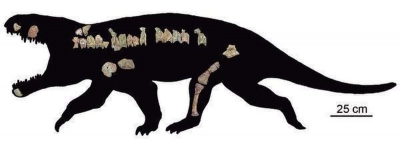
Bharitalasuchus tapani, a carnivorous reptile, lived 240 million years ago. In the Telugu language, Bhari means huge, Tala means head, and Suchus is the name of the Egyptian crocodile-headed deity. The species is named after paleontologist Tapan Roy Chowdhury. The remains were recovered from the Yerrapalli Formation (Telangana) in the 1960’s and housed in the Indian Statistical Institute of Kolkata, but were not studied earlier as they were not complete. The reptiles, belonging to the family of extinct reptiles named Erythrosuchidae, had big heads and large teeth. They were approximately the size of an adult male lion and might have been the largest predators in their ecosystems. Bharitalasuchus tapani were robust animals with big heads and large teeth, and these probably predated other smaller reptiles. It belongs to a genus and species previously unknown to science. They were approximately the size of an adult male lion and might have been the largest predators in their ecosystems. It contains a single species, Bharitalasuchus tapani, known from a holotype and paratype consisting of tooth-bearing cranial fragments. In the Telugu language, Bhari means huge, Tala means head, and Suchus is the name of the Egyptian crocodile-headed deity. The first Erythrosuchidae remains were discovered in South Africa in 1905 and more were found in China and Russia. The South African one is about 245 million years old, while the ones from China and Russia are around 240 million years old. So the Indian one is one of the youngest fossil records we have of an erythrosuchid.
Credit : Journal sof india
Picture Credit : Google




